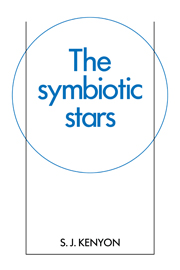Book contents
- Frontmatter
- Contents
- Preface
- 1 Introduction
- 2 The Quiescent Phase - Theory
- 3 The Quiescent Phase - Observations
- 4 The Outburst Phase - Theory
- 5 The Outburst Phase - Observations
- 6 The Formation and Evolution of Symbiotic Stars
- 7 Epilogue
- References to Chapters 1-7
- Appendix
- References to the Appendix
- Subject Index
- Individual Stars
- Frontmatter
- Contents
- Preface
- 1 Introduction
- 2 The Quiescent Phase - Theory
- 3 The Quiescent Phase - Observations
- 4 The Outburst Phase - Theory
- 5 The Outburst Phase - Observations
- 6 The Formation and Evolution of Symbiotic Stars
- 7 Epilogue
- References to Chapters 1-7
- Appendix
- References to the Appendix
- Subject Index
- Individual Stars
Summary
It has been over fifty years since P. Merrill and M. Humason of Mt. Wilson Observatory reported the discovery of three M-type giant stars with an unusually strong He II λ4686 emission line. Astronomers at Harvard College Observatory found each of these “stars with combination spectra” was a long-period variable, and two of them, CI Cyg and AX Per, had undergone a 3 mag nova-like eruption in the previous thirty years. New objects were added to this group of peculiar variables over the next decade: some of these exhibited the regular radial velocity variations expected of a binary system, while other systems appeared to fluctuate randomly and were thought to be single stars. P. Merrill eventually coined the term “symbiotic stars” to describe objects whose spectra simultaneously display features associated with red giant stars and planetary nebulae.
Symbiotic stars are now commonly accepted as binary systems, in which a red giant star transfers material to its hotter companion. Interactions between the components of a binary system are of special interest in astrophysics today, and symbiotic stars present an exciting laboratory in which to examine such basic physical processes as (i) mass loss from red giants and the formation of planetary nebulae, (ii) accretion onto compact stars and the evolution of nova-like eruptions, and (iii) photoionization and radiative transfer within gaseous nebulae. The physical conditions found in these systems are usually very extreme, and they therefore present activity not easily observed in other binaries.
- Type
- Chapter
- Information
- The Symbiotic Stars , pp. vii - viiiPublisher: Cambridge University PressPrint publication year: 1986



